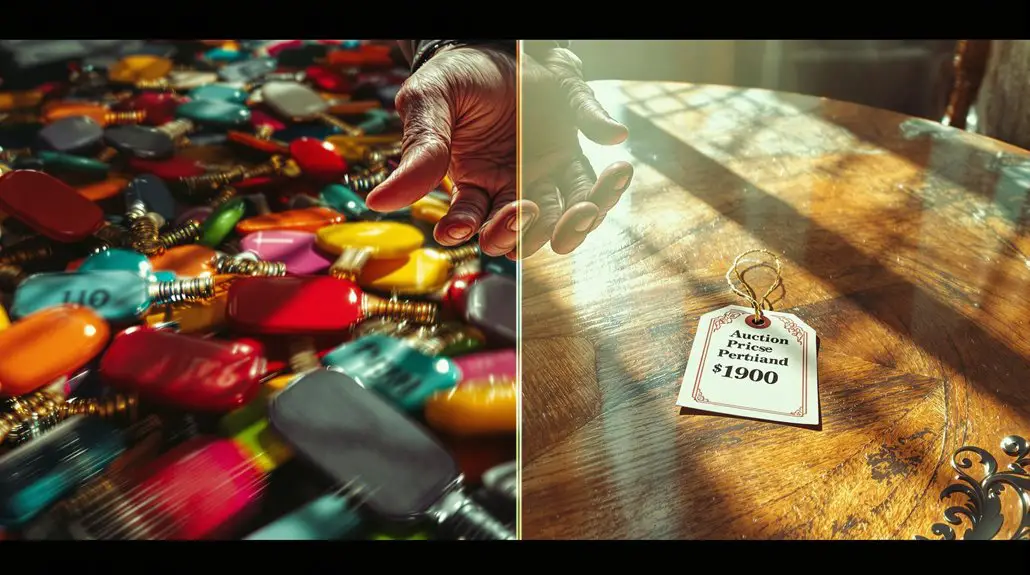When you're figuring out how to sell those vintage treasures on eBay, it's not just about putting a price tag on them; it's about creating an experience. Go for an auction if your item is like that rare chocolate cake everyone wants a slice of; competitive bidding can bake up some excitement, and might end up bringing you more pennies than expected. Or, if you're aiming for simplicity like offering a favorite candy from your shop, a fixed-price listing lets buyers grab it and go, avoiding the bidding hassle. Each has its charm and potential, so the path you choose depends on the dance you want to lead between item and buyer. Want to get the rhythm right for these two beats? Keep exploring, and soon, your sales will hit the perfect note.
Auction Basics
Imagine laying out your items on the living room table, each vying for their starring moment, the suspense building. You're setting the stage here, starting with a price you're willing to let your treasure go for, a floor price if you will. Then, you've got to choose your runway duration—ranging from one intense day to a ten-day drama. Feeling a bit secretive? You can also slap on a reserve price, ensuring you don't part ways with your item for less than what you secretly whisper to yourself as fair. And the bidding war? Oh, it's like a silent disco, the climax of any good story, where the highest bidder claims their prize. But remember, eBay auctions often lead to higher final sale prices than fixed-price listings due to competitive bidding. In these auctions, knowledge about vintage clothing trends can significantly influence buyer interest and engagement. To ensure you're making the most of your sale, factor in the Depop seller fees which can provide insights into pricing strategies across platforms. Managing expectations is key; setting a return policy might just be your auction's plot twist, drawing in those cautious but curious buyers. And, for the love of drama, throw in a Buy It Now button—sometimes love, or a particularly great pair of vintage boots, never waits. Let's not forget the nitty-gritty of eBay's fees, because even digital auctions have their cost, including potential payment processing fees that can affect your overall earnings.
Fixed-Price Overview
If you opt for fixed-price listings on eBay, you'll find they're a straightforward affair, making your life as a seller *much* easier. They're the culinary equivalent of a tried-and-true family recipe: predictable and comforting, garnished with just the right ingredients. The fixed price structure gives buyers that reassurance – they know exactly what they'll pay, no stress over bidding wars or last-minute snipes. And let's be honest, who doesn't appreciate a break from the rollercoaster of the auction format?
With fixed-price listings, you can also leverage eBay's Buy Now feature, allowing instantaneous purchases without the waiting game of auctions.
Now, setting a fixed price isn't just about simplicity, but it's also a smart move for your wallet. You set your price, and in return, eBay offers higher average sale prices compared to the unpredictable auction results. And imagine this: your listings don't vanish after a fixed time; they remain in search results until sold, much like a seasoned artist at a gallery, giving you ongoing exposure. Plus, inserting fees can be pleasantly low – sometimes even free – with tools and subscriptions, and with auto-renewal, your listings get refreshed effortlessly, keeping your art on display, sans the hassle.
Auction Vs Fixed-Price
You've got choices when selling on eBay: auctions or fixed-price listings. When you're ready to sell your treasure, consider a few things:
- Price Control: Want to set your own price? Go for fixed-price. It's like setting a sign outside your yard sale; the decision is made immediately.
- Bidding Thrill: You love watching people fight over your old cowbell? Auctions create that competitive edge, where the drama unfolds in bids, not unlike friends vying for dibber-dibber – who's gonna get it? Auctions average a 7-day selling duration, adding a bit of ceremony to the selling process. Selling vintage items can also arouse significant price changes based on buyer interest and rarity, enhancing the excitement of bidding.
The auction's got its charm, like a gambling excitement, a thrill ride for every bidder. It often feels like a game where everyone's trying to find that unique item at the cheapest price possible.
Still, there's a strong argument for fixed:
– Buyer Convenience: Today's shoppers crave the click-and-buy simplicity of Amazon. Fixed-price listings tap into this, capturing the now-now-now want of the instant gratification generation.
Despite the auction's allure, don't overlook its unpredictability; your item won't get the bids if it's not unique or interesting.
Choosing the Right Format
Choosing between auction and fixed-price formats on eBay calls for thinking about what you're selling, like when you're sorting through Aunt Betsy's attic treasures. If it's a rare, high-value gem, you might find that opening your door to competitive bidding seems like her boxing day specials, teasing out the sense of urgency and scarcity, which auctions do best.
Just imagine that 19th-century typewriter Aunt Betsy treasured but never used; it's almost sinful not to let collectors battle it out.
But if you're dealing with common items that have a steady line of middle-ground enthusiasts, setting a fixed price is like putting out a "Buy Now Before It's Gone" sign.
All you gotta do is click, and it's yours—quick, simple, and efficient, tailored for the market's perpetual hustle.
And don't overlook the preparation dance. High-quality images and impeccable item descriptions are your choreographers here, regardless of format.
You're setting the stage for that dramatic reveal, where every detail counts to catch the eye of the right buyer, transforming your vintage item into their newfound must-have.
Pros and Cons Comparison**
When deciding between auction and fixed-price formats on eBay, you're faced with a choice that greatly impacts how your item sells. Auctions might just light up that spark of excitement, giving your rare vintage finds a chance to shine in front of keen collectors:
- Bidding Wars: You could watch the price soar as bargain-hunters throw digital dollars at each other, creating an auctioneer's dream.
- Unpredictable Outcomes: It's a gamble, like trying to guess the next card in a magic trick; the outcome keeps you guessing.
- Faster Sales: The ticking clock adds urgency; your precious items could fly off the virtual shelves faster than hot cakes at a fair, especially if you leverage competitive pricing that draws buyers in.
Fixed-price listings, on the other hand, offer a blend of predictability and control over your sales:
- Instant Purchases: Your items sit attractively on the virtual shelves, gleaming under the virtual lights, waiting for that instant 'aha' moment from buyers.
- Predictable Outcomes: It's like setting the terms of your adventure, controlling the flow of commerce with the ease of flipping a price tag.
- Strategic Pricing: You can leverage insights from significant discounts to set your prices competitively, utilizing tools like a fee calculator to enhance your pricing strategy.
Choosing the right format guarantees you're not just selling an item; you're intriguing your buyer.



